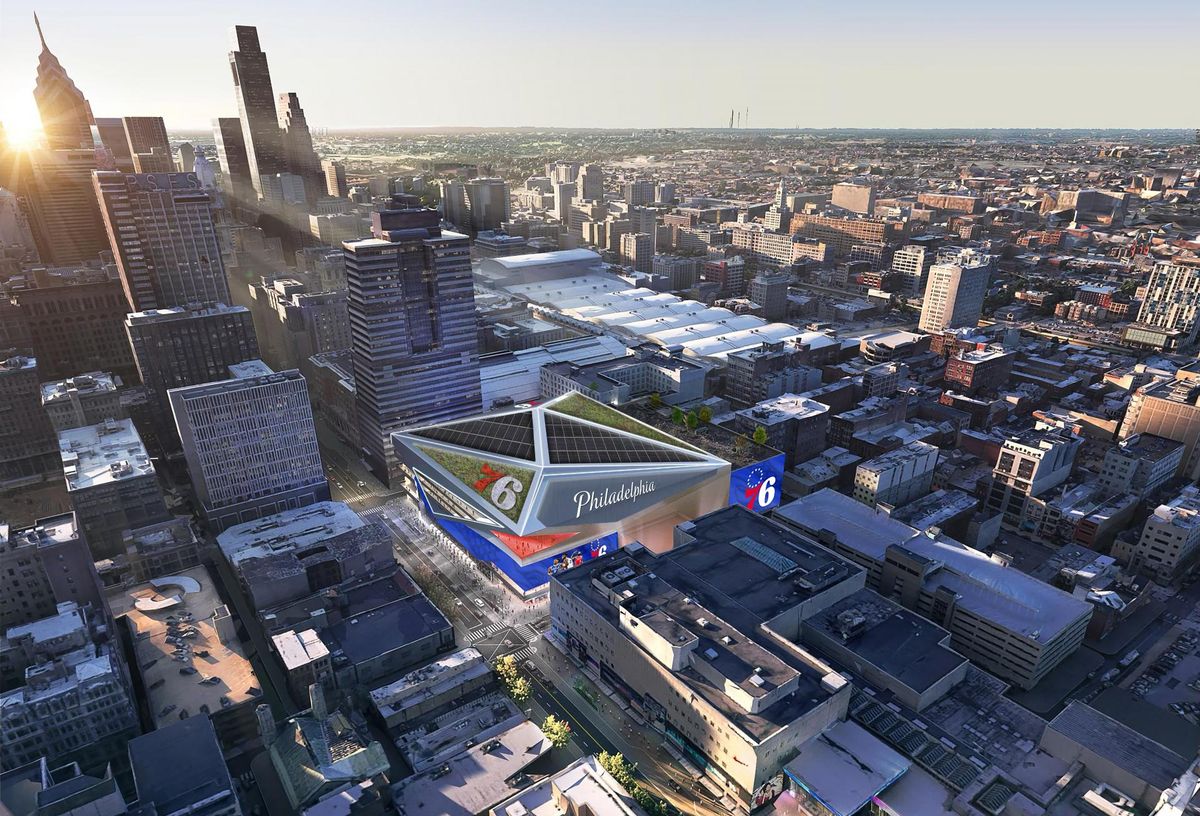THE Philadelphia Industrial Development Corporation. East eight months late by releasing an economic and community impact report that could decide whether city officials take the 76ers’ land bid to build a $1.5 billion arena City center.
The key decision-makers are growing impatient. In recent weeks, two studies by consultants have been published that have come up with potentially radically different economic and commercial real estate outcomes if a second major stadium is built.
Who should believe the CRE? Neither, several economists said Bisnowadding that the impact of two stadiums on the industry would be more nuanced. But the more likely outcome is that rather than doubling opportunities, hosting two large stadiums would simply redistribute where the business takes place, spreading a limited number of dollars across a wider canvas.

Courtesy of 76 DevCo
A rendering of the Philadelphia 76ers’ new home on Market Street between 10th and 11th streets. Plans call for a green roof and solar panels.
“All they have to do is convince some people that this number is objective when it’s not,” said Dennis Coates, an economics professor at the University of California, Berkeley. University of Maryland, Baltimoresaid of the rival reports from the 76ers organization and Comcast Spectacor, including Wells Fargo Center In South Philadelphia, a new arena would compete.
One promises boom times for city coffers, schools and real estate developers who operate in and around a new 76ers arena. The other says dueling arenas would divide the market, draining attendance and potential revenue from both.
Economists say these studies rely on different benchmarks that serve a specific purpose and are not a good guide for local developers, politicians or other stakeholders in decision-making, especially this year or at any stage prior to construction.
Coates said the real estate players who stand to benefit from arena development are naturally those who are nearby and could see “greater demand, charge my tenant more or even sell the land,” especially when a stadium opens, he said.
But those near venues that lose a regular team, even to a stadium a few miles away, are prepared to take on a corresponding amount of business, he said.
Comcast Show owns the Wells Fargo Center where the 76ers will continue to pay rent through 2031. study Construction of a new basketball arena could lead to gentrification in Chinatown and a decline in overall event ticket sales, which would weigh on the facility and associated development, according to real estate consultancy Hunden Partners, noting that Philadelphia has historically underperformed in entertainment spending compared to other cities its size, according to Pollstar Data.
That could spell trouble for both arenas in 10 to 20 years, when lack of sufficient revenue and aging means the costs of redeveloping the facilities could be borne by taxpayers, the study’s authors said.
“We firmly believe that the best outcome for our fans and the community is for the 76ers and Comcast Spectacor to be united and headquartered in South Philadelphia,” said Daniel Hilferty, chairman and CEO of Comcast Spectacor. said earlier this month.
Comcast Spectacor plans to rethink your own game of South Philadelphia’s stadium district to include thousands of homes and other facilities, potentially seeking $2 billion in government support for the project.
Neither Comast Spectacor nor the 76ers organization have offered a spokesperson for comment. Bisnow.
But that doesn’t mean 76 DevCo, the company created to promote the Sixers’ vision, has been silent. Supporters of the $1.5 billion privately funded plan said in a statement that the Hunden study failed to account for the growth of the entertainment industry..
The 76ers owners also presented their own commissioned study concluding that the net economic benefit of a new downtown arena would be $776 million, including $202 million for city schools over 30 years.
And 76 DevCo executives David Adelman has been categorical that neither the redux of the South Philadelphia Sports Complex nor the appeal of New Jersey’s tax credits for move the arena plans across the river in Camden, New Jersey, will impact plans to relocate the team to its own downtown stadium.

Courtesy of Comcast Spectacor.
A rendering of Phase 1 of Comcast Spectacor’s South Philadelphia Sports Complex redevelopment.
The reality of new arenas, however, is that they tend to have little economic impact beyond their four walls, economists said. BisnowInstead, new arenas end up moving jobs, events and ancillary development from one location to another.
“Certainly moving NBA games just moves those 41 dates from one location to another,” he said. Victor Mathesonprofessor of economics and accounting at the College of the Holy Cross. “All the big concert tours already come through Philadelphia, so you’re not likely to get a lot of people there. [by adding an arena].
“And even the big arenas in big cities still only have about 30 concert days a year, which means that even with an NBA and NHL team and being the only major indoor concert venue, the current arena is dark more than half the days each year,” Matheson added.
76 DevCo argues that Philadelphia is one of the largest metropolitan areas in the country, but only the 13th busiest entertainment market, showing there is room for growth—the same statistic Comcast Spectacor used to argue against the need for two large venues. That study estimates that a new venue could accommodate a dozen additional shows per year.
Former Ticketmaster CEO Irving Azoff is among those supporting building a second arena to build what he sees as a maturing entertainment market.
“The fact is, the biggest bands need weekend nights to be successful on tour, and those nights are taken up at the Wells Fargo Center by two professional sports teams,” Azoff said. Bisnow in a statement. “There could easily be 50 more events in the city if a new arena were built with a schedule, design and programming that caters to both concerts and events.”
Matheson also said the 76ers’ plan to move to a part of the Fashion District above Jefferson Station in the heart of the city makes perfect sense. Its location and the impact on surrounding businesses could outweigh staying put. Placing stadiums away from bars, restaurants and hotels encourages more travel to and from events rather than staying and spending, he said.
However, given that commuters make up the vast majority of people attending events, it is difficult to make the case for relocation. Temple University said economics professor Michael Leeds.
“I don’t see how, with a second venue, they can’t cannibalize the performances of the other ones that are second-tier,” Leeds said. “The reason teams have moved from highly urbanized areas to the outskirts of cities or out of cities is because of the lack of parking. So it goes against 60, 70 years of American history. I don’t know if you’re going to change that right away.”
Nor do the data confirm that new jobs and businesses are being created by new arenas. A study found no evidence of the increase in the number of new business openings following the opening of new sports facilities in 12 U.S. cities in the 2000s.
A full review Of the 130 studies on the economic impact of sports teams and stadiums conducted by Maryland’s Coates and two other researchers, one important finding was that teams and stadiums are not associated with a strong economic impact on local communities, and the often-cited spillover effects of increased business activity and profitable development have not materialized.
A growing body of research indicates that new stadiums and arenas geographically reorganize existing activity since adding new locations does not put more money into the public’s pockets to spend there.
Studies from self-serving commercial entities have a purpose, but not necessarily to serve public and commercial interests, economists said.
“These studies, sponsored studies, on the impact of sports facilities are very precise and very accurate, except that they put the comma in the wrong place. The real impact is one tenth or one hundredth of the reality, [as] “My colleague once said,” Leeds said.
“There is a problem, but I’m not sure what they are proposing is a solution.”

